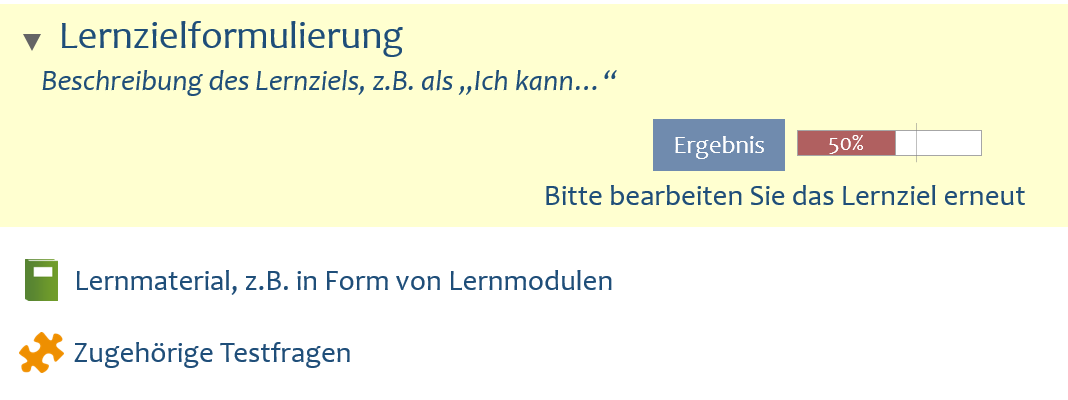Reiter
learning objective driven course view
A learning objective driven course is primarily a presentation style for courses. Instead of being sorted by meetings or being unsorted, content is categorized by learning objectives determined by the teacher.
Learning objectives consist of:
Learning objectives consist of:
- Name and description
- Test questions comprising one or more tests
- Content of the ILIAS-course that is assigned to the learning goal (learning modules, web links, files, in short: everything that is part of the course)

- Learing objective descriptions give students an overview of the goals to be reached in this course.
- By assigning specific test questions, teachers transparently communicate expectations.
- This structure makes it possible to connect content and learning objectives
- Individual progression bars give visual feedback to students about what they have accomplished and how much they still have to do
Depending on your scenario there are different ways in which you can determine the progress. In each case you create test questions but there are different kinds of initial and final tests. In the setup of a learning objective driven course you choose one option each from the respective sets.
Entry test (optional)
Initial Test
- Comprehensive placement test
- covering all objectives
- separate placement test for each objective
- Comprehensive achievement test
- covering all objectives
- separate achievement test dor each objective
- No initial test
Learning content
Content
Students receive visual feedback on their individual progress within the learning objective. Objectices that have not been met can be worked on accordingly.
Students receive visual feedback on their individual progress within the learning objective. Objectices that have not been met can be worked on accordingly.
Final test
Final Test
- Final test covering all objectives
- Separate final test for each objective
Difference between placement and achievement tests:
- The progress bar of a placement test is grey instead of red/green.
- Objectices are thus taken more as suggestions.
- Technically, a learning objective does not count as completed when a placement test has been passed.
The option "Comprehensive final test covering all objectives" shuffles the questions of all learning objectives of a given course. Answering these questions can be more difficult because the explicit context of a learning objective is missing.
Making a difference between entry and final exams is only necessary if the questions of the two tests are different ones. If exams are used as a tool for self-evaluation, setting up final exams suffices.
Making a difference between entry and final exams is only necessary if the questions of the two tests are different ones. If exams are used as a tool for self-evaluation, setting up final exams suffices.
Preview learning objectives after diagnostic test


Preview learning objectives after qualifying test


More info on the learning objectives:
The progress bar is only visible to learners. Teachers can only derive progress from the test results.More info on the learning objectives:
The progress bar is only visible to learners. Teachers can only derive progress from the test results.More info on the learning objectives:
Further information regarding learning objectives:
The individual progress bar can only be seen by the respective student. Teachers can determine learning progress by test results only.
The individual progress bar can only be seen by the respective student. Teachers can determine learning progress by test results only.
Tutorials
Since the videos are in German, please follow the English descriptions below.
What is a learning goal oriented course?
Create a learning goal oriented course
How to create a learning objective driven course
- After you have created a course, switch to the tab "Settings". There you can set a course to be a "Learning Objectives-Driven Course".
- Scroll to "Course Presentation" and select option "Learning Objectives-Driven Course". Confirm your changes by clicking „Save“.
- A new tab appeared: "Learning Objectives". Here you can set the structure of your study goal oriented course.
Learning Objective Settings
- In a course that contains learning objectives that build on one another, it is recommended to create final tests for every learning objective. In this case an initial test is not necessary.
- Confirm your input by clicking „Save“.
Create learning objectives
- Change to the tab "Learning Objectives" and enter a name for your learning objective in the respective text box. By clicking "+" or "-" you can set the number of learning objectives for your course.
- Confirm your input by clicking „Save“.
- You will see a site for test attribution. By clicking "Learning Objectives" once again below the tab's name you can change the learning objective's details: Click the button that is located below the column „Actions“ and select "Edit". Add a description to your learning objective and confirm your input by clicking „Save“.
Assigning tests or test questions to learning objectives
- To add tests to your learning objectives, click the button "Final Test" that is located below "Learning Objectives". Here you can decide between creating a new test or choosing one that you have created before.
- In the learning objectives overview you can add a final test by clicking on the blue arrow on the right hand side and choosing "Assign Questions of Final Test".
- The process of referring an exam may be easier when you select "Use Exisiting Test". The drop-down menu displays an overview of the course's already existing exams.
- Select the test that you want to link from the list of existing tests.
- Select the learning objective that you want your selected exam be referred to.
- Confirm your input by clicking „Save“.
Assign materials to learning objectives
- When looking at the "Learning Objectives" overview, you can assign study material to the learning objectives.
- Click the button below the column „Actions“ and select the option "Assign Material". Then a list of all of the course's content is being displayed.
- After assigning study materials to a learning objective, confirm your input by clicking „Save“.
click here for German version